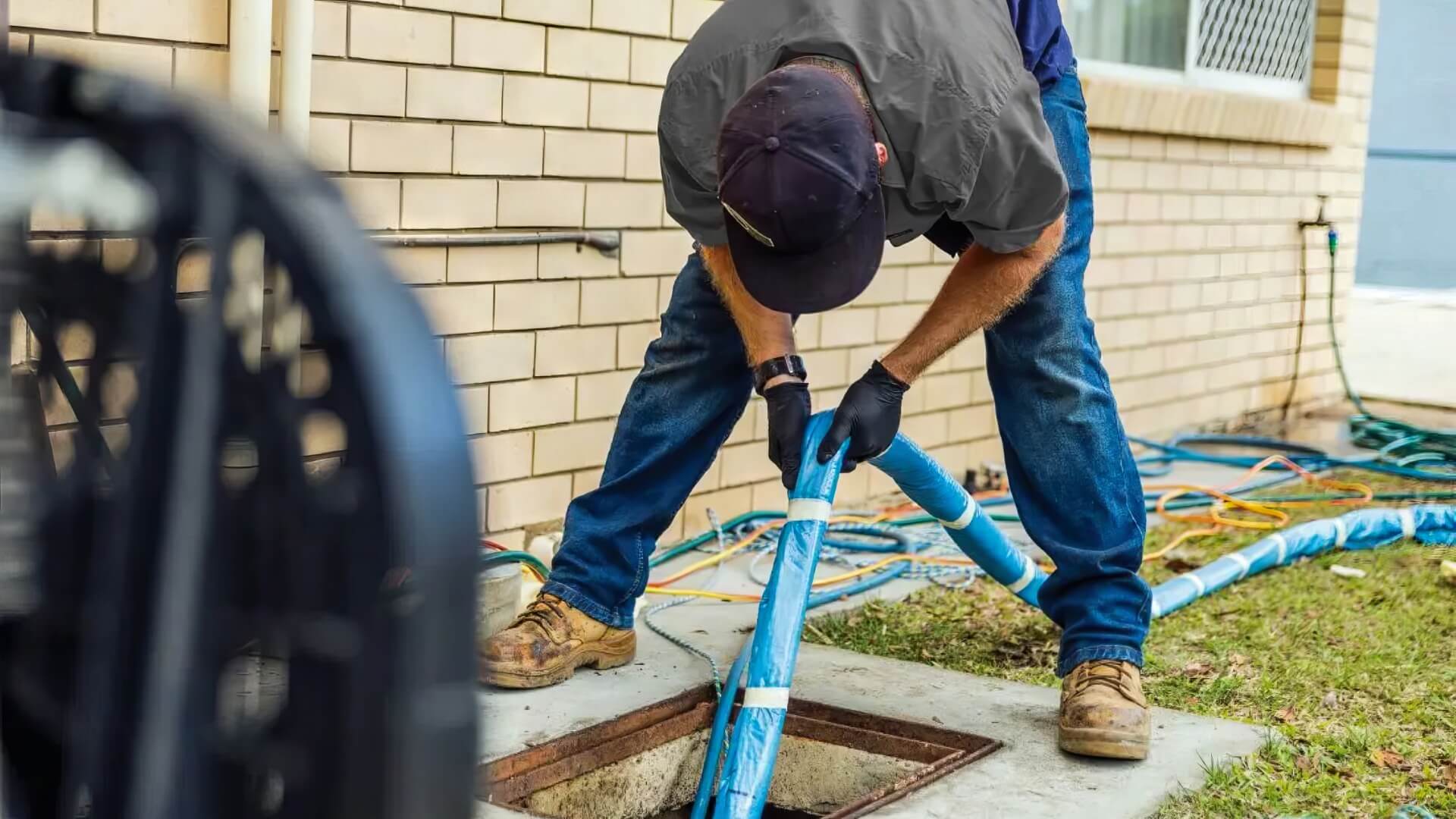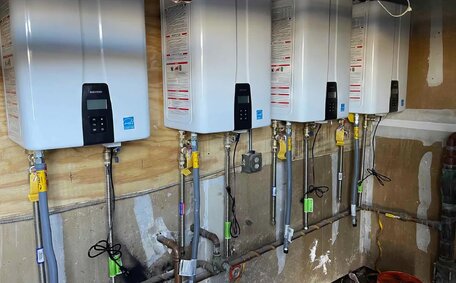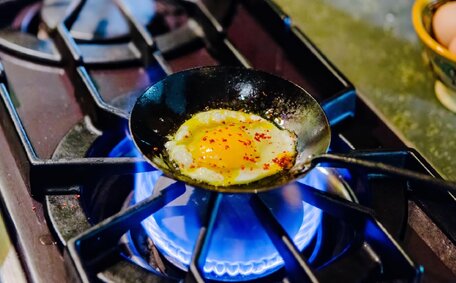An Introduction to Pipe Relining
Renew your plumbing efficiently with pipe relining, an advanced trenchless repair method that forgoes the need for traditional pipe replacement. It involves using techniques where we use a composite resin liner to be blown into broken pipes, where it cures and hardens to form a smooth, leak-free inner surface.
As a leading plumbing company serving Colyton and the urban utilities of the greater Sydney area, At Colyton Plumbing, we provide complete relining services to revitalise your damaged pipes for both residential and commercial properties. Relining repairs damaged pipes, restoring water pressure, preventing leaks, and improving flow rates, all achieved without excavation or destruction.
We’ll also touch on how our robust relining solutions have the potential to enhance your property’s water pressure over time.
How Pipe Relining Works
Pipe relining entails injecting an epoxy resin liner into damaged pipes, thus eliminating the need for excavation. This liner, designed to fit seamlessly into existing damaged pipe infrastructure, expands to fit firmly against the inner walls of the host pipe. Once in place, the resin cures and hardens, creating a smooth, seamless new pipe lining, which is stronger than the existing structure.
Pipe relining is a trenchless technique, which is accomplished without digging or causing destruction to floors, yards, driveways, or landscaping. For the pipe work on your drain, small access points are opened at entry and exit points, allowing the liner to be introduced into the original pipe.
Our skilled technicians reline old pipes with a new lining, creating jointless, watertight pipes within the existing system. This not only stops leaks in your sewer line but also ensures to get the job done to enhance water flow and pressure. Having a relined pipe interior with no protrusions, built-up mineral deposits, or cracks enables water to flow freely.
This method effectively prevents corrosion and abrasion.
Certain pipe materials like PVC pipes, clay, and iron, which are more prone to build-up and cracks than PVC, deteriorate over time.
Relining ensures a consistent diameter, eliminating such obstructions.
The Process of Installing an Epoxy Pipe Lining
The installation of an epoxy pipe lining, critical for efficient drains, follows a multi-step approach by specialist technicians:
- First, the existing pipe is thoroughly assessed, using CCTV technology, to identify any damage or obstructions. The pipe undergoes a thorough drain cleaning, ensuring everything is cleaned up using high pressure water jetting.
- A liner soaked in specialized composite resin materials is then inserted into the pipe using compressed air. The liner expands to fit firmly against the pipe walls.
- The epoxy liner pipe is then cured, either by introducing hot water or steam, or via UV light. Curing times vary based on the resin materials used.
- Once cured, the epoxy liner has formed a smooth, jointless pipe lining within the host pipe. This technique not only waterproofs the system but also optimises water flow and pressure without the need to dig.
- We strongly endorse this process, as it can extend the lifespan of ageing pipes by over 30 years. All work is trenchless and requires just small access points into the pipe.
The epoxy cure is a chemical process utilised in sewer repair, ensuring a robust Polyethylene pipe can result, bolstering your plumbing. The result is a new, problem-free section of piping with improved flow capacity, including sewer pipes.
Advantages of Pipe Relining for Improving Water Pressure
When your property does need pipe solutions that enhance water pressure, relining offers several key advantages:
- Increased Flow Capacity - The smooth, uniform surface of a pipe lining maximises the flow rate in both sewer and drainage systems. Relined sewer lines have up to 2% more capacity than the original pipes.
- Fewer Obstructions - Old pipe materials accumulate mineral deposits, protrusions, and cracks that impede water flow. Epoxy linings provide an obstruction-free surface.
- Resistance to Tree Roots - Pipe Relining can offer more resistance to root infiltrations than traditional methods, significantly surpassing conventional pipe solutions.
- Less Environmental Impact - The environmentally friendly trenchless relining provides better protection than traditional pipe methods, as it avoids excavation, reducing water waste and thus leading to less property damage and better protection for storm water systems from contamination.
- Faster Installation - The cured in place linings can be installed, often in just one day, ensuring the flow of water is not disrupted for long hours.
A Smoother Pipe Surface Reduces Friction
A key benefit of pipe relining is that it creates an exceptionally smooth interior pipe surface. Epoxy resin liners form a uniform, obstruction-free layer inside an existing pipe. This smooth surface helps to reduce turbulence and friction as water flows through the pipe.
Old pipe materials like concrete, clay, and cast iron often have mineral deposits, cracks, protruding joints, and corrosion that interrupt water flow. As potable water passes over these obstructions, it creates turbulence and friction, which restricts flow rates. This can reduce water pressure.
An epoxy pipe lining provides a seamless, jointless surface without any of these flow hindrances. This allows water to flow freely without friction slowing it down. Less friction results in better flow efficiency and maintenance of water pressure within the pipe.
A smooth pipe surface also results in quieter water flow. The absence of protrusions and build-up eliminates potential noise sources from rushing water. Compared to their counterparts, relined pipes typically function more quietly and efficiently.
Overall, epoxy relining transforms rough, damaged pipes into smooth-surfaced conduits. This reduces turbulence, friction, and noise while optimising flow rates and water pressure delivery.
Eliminates Obstructions like Roots and Buildup
One of the benefits pipe relining offers is the elimination of obstructions within pipes that hinder water flow and reduce pressure. Two common culprits are root intrusion and mineral/debris buildup.
A tree root can infiltrate pipes through small cracks and joints, causing significant damage. As roots grow, they expand and can also block water flow. An epoxy liner can help improve the pipe’s resilience by plugging leaks, which prevent tree roots from penetrating, offering robust protection against future root infiltration.
Old pipe materials like cast iron and concrete are also vulnerable to mineral deposits accumulating over time. This buildup narrows the plumbing pipe diameter, restricting flow. Relined pipes ensure a more consistent diameter that helps improve flow compared to original, rough pipes.
Pipe relining can fix pipes by sealing them from root intrusion and preventing mineral/debris deposits, thus optimising flow capacity. Eliminating obstructions means improved pressure delivery for showers, taps, sprinklers, and all other water fixtures.
Increased Flow Capacity and Pressure Balance
Drain relining can effectively remedy blocked drains and increase the flow capacity of drain pipes. As previously mentioned, epoxy liners provide a smooth, uniform diameter without obstructions. This enhances water flow through the piping system.
A higher flow capacity ensures more even water pressure distribution throughout your home, even in previously problematic fixtures. There is less friction and fewer bottlenecks slowing down pressure delivery. Thus, showerheads, faucets, and appliances receive adequate, consistent water pressure.
For residential plumbing, the ideal water pressure range is 45 to 80 PSI. Pipe relining helps achieve balanced pressure within this range so all household needs are met without straining the drainage system.
The absence of leaks post-relining also maintains pressure balance. Previous leaks would have contributed to drops in pressure from continual water escaping the system. Sealing these leaks helps to make sure the overall pressure is preserved, which can enhance distribution throughout a property.
Increased flow capacity and reduced leaks enable consistent pressure delivery throughout a property. Pipe relining aligns with the ideal PSI for residential settings, ensuring all household fixtures function as intended.
Considerations Before Opting for Pipe Relining
Before deciding on pipe relining, homeowners should evaluate a few key factors:
- Assess Pipe Condition - Inspect materials, age, leak and root history to determine if relining is suitable. CCTV surveys provide detailed analysis.
- Identify Pipe Layouts - Relining requires access to pipe endpoints. Technicians need insertion and exit points.
- Consider Related Repairs - Other repairs like junction realignment may require more attention for successful relining.
- Compare Cost vs Replacement - Get quotes to compare savings against full pipe replacements.
Comprehensive assessments are essential for understanding pipe conditions, confirming material suitability, and avoiding unsuccessful relining. CCTV inspections provide homeowners with expert analysis on the current state of pipes. Such evaluations support fully informed decisions about whether your pipes are suitable for relining.
Pipe Relining vs. Full Replacement: Cost and Value Comparison
Pipe relining can save homeowners substantially compared to full pipe replacement. The pipe relining cost, being more cost effective than other methods, averages $80-250 per linear foot, while full replacement can range from $200-500 per linear foot. The exact pricing for both options depends on pipe size, length, materials, location complexity and labour.
Beyond direct cost savings, pipe relining offers additional value:
- Minimal Inconvenience - Relining is a trenchless process requiring only small access points into pipes. Replacement involves extensive excavation and property disruption.
- Faster Solution - Epoxy liners can be installed in hours with no long-term service interruptions, compared to replacement projects taking days/weeks.
- Longer Lifespan - The smooth epoxy lining is resistant to corrosion, abrasion and future root infiltration, ensuring that your pipes can last for decades.
- Environmental Benefits - Relining results in far less landfill waste and property damage from digging up pipes.
Epoxy pipe relining offers comparable stability and performance to replacement while being more cost-effective and convenient.
Conclusion and Recommendations
Pipe relining, with its non-intrusive approach, is a cost-effective solution to restore and boost water pressure in residential plumbing systems. Compared to full pipe replacement, relining is a more affordable trenchless method that provides long-term durability and performance.
Key benefits covered in this article include:
- Increased flow capacity and less friction
- Obstruction removal and root intrusion prevention
- Enhanced pressure balance and consistency
- Faster installation and minimal property disruption
I called on readers to find out more by contacting Colyton Plumbing for quality work and to learn about pipe relining and how it can rejuvenate their property’s water pressure. We also welcome homeowners who need to repair pipes to schedule an appointment with our specialists to further evaluate their plumbing systems.
Colyton Plumbing, serving Colyton and nearby areas, offers effective solutions using advanced repair methods minus the costs and hassle of traditional repairs. Find out how trenchless pipe relining can improve your water pressure for the long term.






